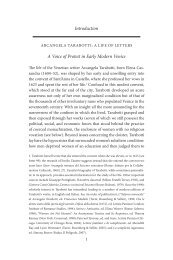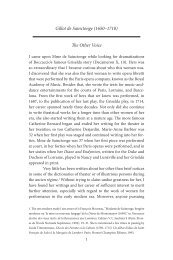Excerpt - Iter: Gateway to the Middle Ages and Renaissance
Excerpt - Iter: Gateway to the Middle Ages and Renaissance
Excerpt - Iter: Gateway to the Middle Ages and Renaissance
You also want an ePaper? Increase the reach of your titles
YUMPU automatically turns print PDFs into web optimized ePapers that Google loves.
2 Edi<strong>to</strong>r’s Introduction<br />
According <strong>to</strong> An<strong>to</strong>ine du Moulin’s preface <strong>to</strong> <strong>the</strong> first edition of<br />
<strong>the</strong> Rymes, <strong>the</strong> young woman’s grieving husb<strong>and</strong> brought her poems<br />
<strong>to</strong> light after her death, providing a socially acceptable context for<br />
publishing love poetry by a woman, an o<strong>the</strong>rwise risky venture at that<br />
time. Literary tradition has long linked Pernette du Guillet’s name with<br />
that of Maurice Scève, identifying Du Guillet as <strong>the</strong> inspiration for<br />
Scève’s Délie (Lyon, 1544). She herself inscribed Scève’s name in her<br />
verse through anagrams <strong>and</strong> wordplay, prompting literary his<strong>to</strong>rians<br />
until <strong>the</strong> late twentieth century <strong>to</strong> read her poetry largely in <strong>the</strong> shadow<br />
of Scève’s canzoniere, focusing undue attention on suppositions<br />
pertaining <strong>to</strong> a Pla<strong>to</strong>nic love between <strong>the</strong> two poets, although we have<br />
no external evidence regarding <strong>the</strong> nature of <strong>the</strong>ir relationship. 3<br />
More recent critical approaches <strong>to</strong> <strong>the</strong> Rymes, however, have set<br />
aside this au<strong>to</strong>biographical focus <strong>to</strong> explore <strong>the</strong> collection in ways<br />
that shed light on Du Guillet’s poetic techniques in relation <strong>to</strong> <strong>the</strong><br />
works of her contemporaries <strong>and</strong> predecessors. 4<br />
The poems of <strong>the</strong><br />
Rymes engage in intertextual dialogue with <strong>the</strong> Délie, as well as with<br />
o<strong>the</strong>r important works of poetry <strong>and</strong> <strong>the</strong>ories of love in circulation<br />
in mid-sixteenth-century Lyon, displaying innovative responses <strong>to</strong><br />
those texts. 5<br />
Pernette du Guillet’s literary dialogues with <strong>the</strong> works<br />
of Scève <strong>and</strong> o<strong>the</strong>rs—<strong>the</strong> Rhé<strong>to</strong>riqueurs, Marot, <strong>the</strong> Petrarchan<br />
poets, <strong>and</strong> <strong>the</strong> Neopla<strong>to</strong>nists—reveal a young writer fully aware of<br />
her difference from her male counterparts, both contemporary <strong>and</strong><br />
his<strong>to</strong>rical. Within traditions focusing on <strong>the</strong> experience <strong>and</strong> voice of<br />
3. Joseph Buche first published this identification of Scève’s Délie with Pernette du Guillet,<br />
based on his reading of <strong>the</strong> two works. See “Pernette du Guillet et la de Maurice<br />
Scève,” in Mélanges de Philologie offerts à Ferdin<strong>and</strong> Brunot (1904; Geneva: Slatkine Reprints,<br />
1972), 33–39. As Floyd Gray notes, however, <strong>the</strong> appearance of Scève’s name in <strong>the</strong> Rymes<br />
as anagrams <strong>and</strong> puns is “flimsy evidence on which <strong>to</strong> base a claim for anything o<strong>the</strong>r than<br />
<strong>the</strong> poetic relationship that is assumed here.” Gender, Rhe<strong>to</strong>ric, <strong>and</strong> Print Culture in French<br />
<strong>Renaissance</strong> Writing (Cambridge: Cambridge University Press, 2000), 184.<br />
4. The list of noteworthy studies of <strong>the</strong> Rymes is now (happily) <strong>to</strong>o numerous <strong>to</strong> fit in one<br />
opening footnote. I have indicated particularly relevant publications in <strong>the</strong> notes <strong>to</strong> <strong>the</strong><br />
poems <strong>the</strong>mselves <strong>and</strong> in corresponding passages of <strong>the</strong> Introduction. See also <strong>the</strong> list of<br />
resources in <strong>the</strong> bibliography of this volume.<br />
5. Françoise Charpentier observes that “l’œuvre baigne dans une intertextualité dont Scève<br />
est loin d’être la seule composante, tant au niveau du contenu que de la forme” (<strong>the</strong> work is<br />
ba<strong>the</strong>d in an intertextuality of which Scève is far from being <strong>the</strong> only element, on <strong>the</strong> level<br />
of content as well as of form). “Projet poétique, travail poétique dans les Rymes de Pernette<br />
du Guillet: Au<strong>to</strong>ur de trois quatrains,” in Poétique et Narration: Mélanges offerts à Guy<br />
Demerson, ed. François Marotin <strong>and</strong> Jacques-Phillippe Saint-Gér<strong>and</strong> (Paris: Champion,<br />
1993), 146. Unless o<strong>the</strong>rwise indicated, all translations of secondary sources are my own.




